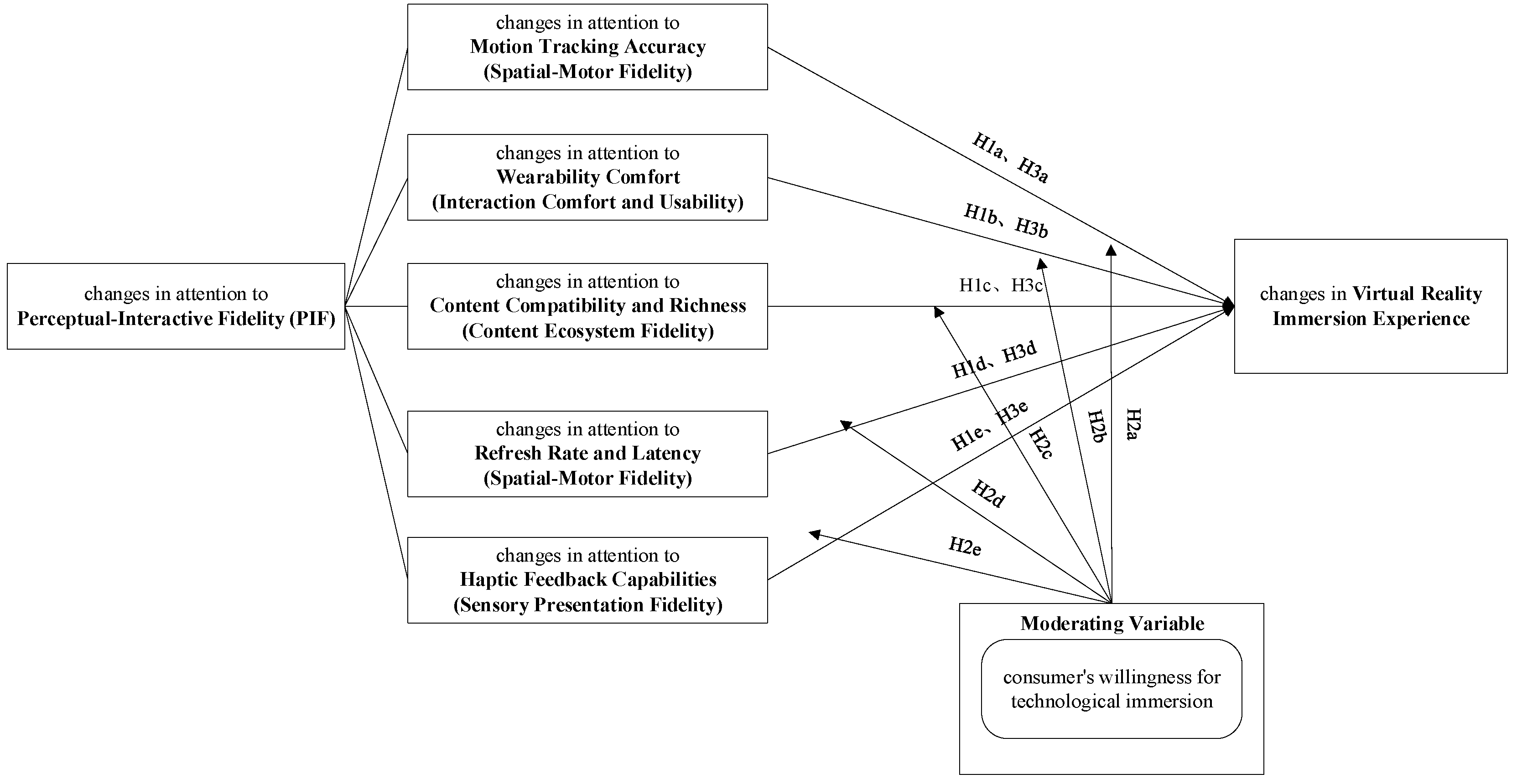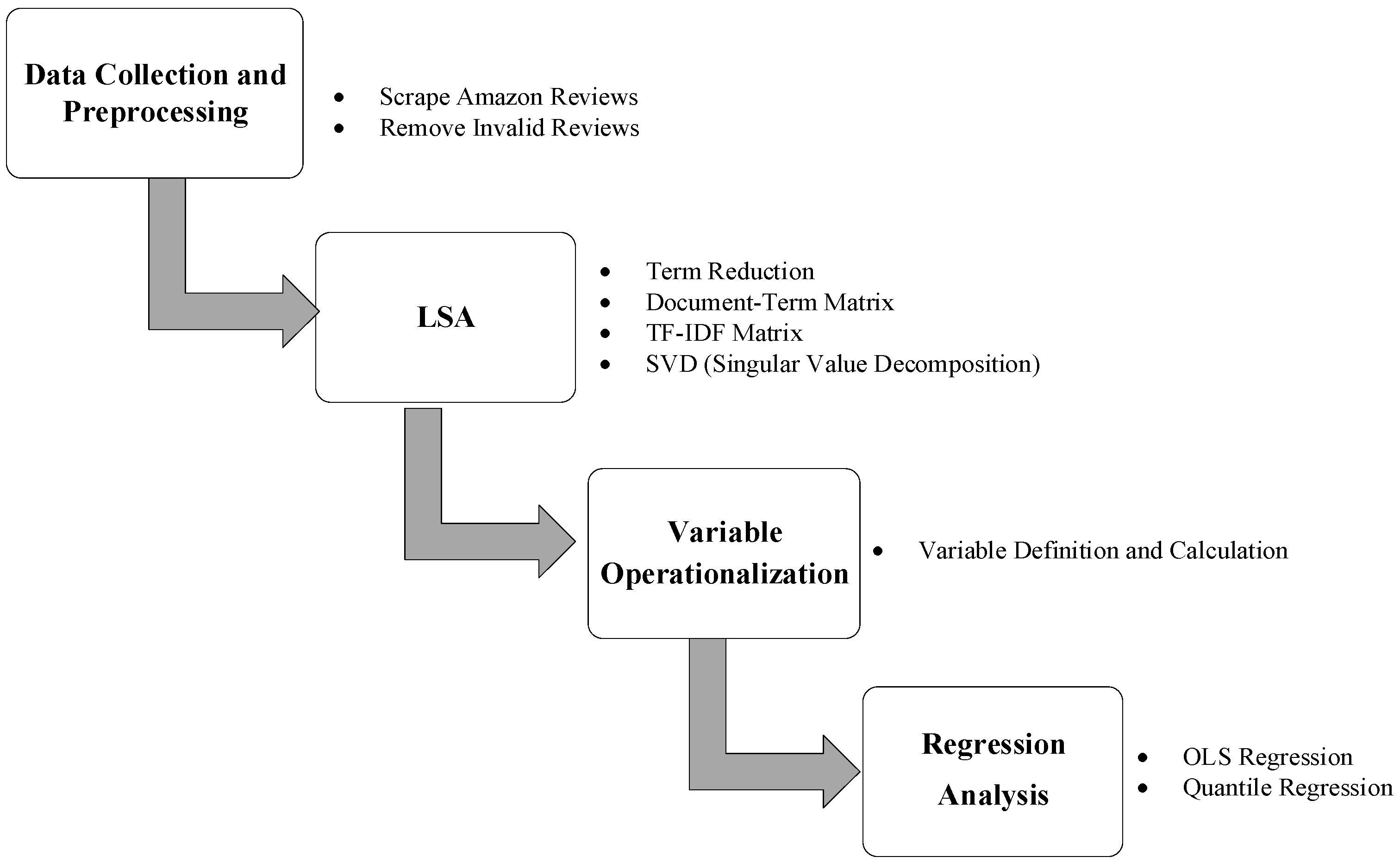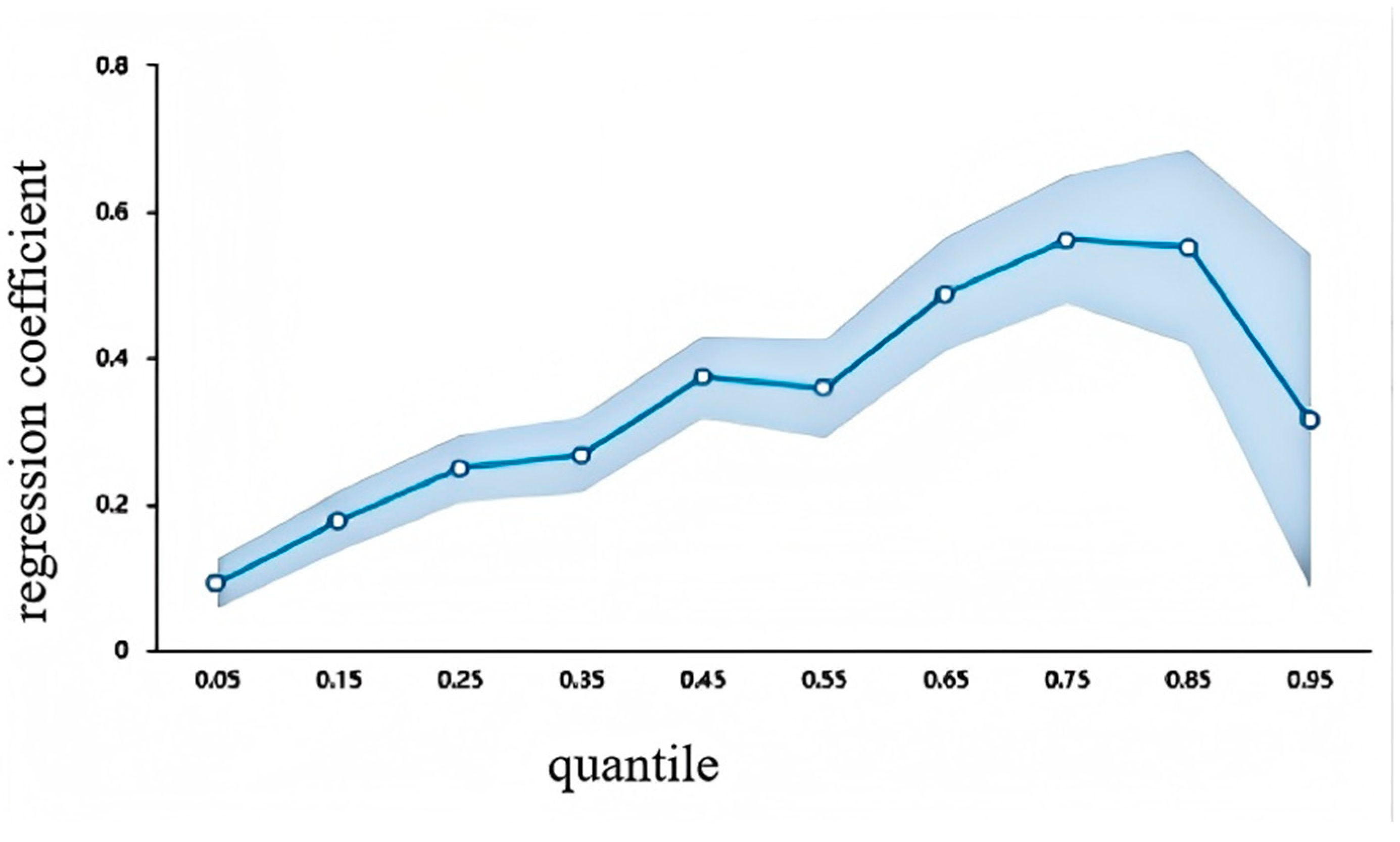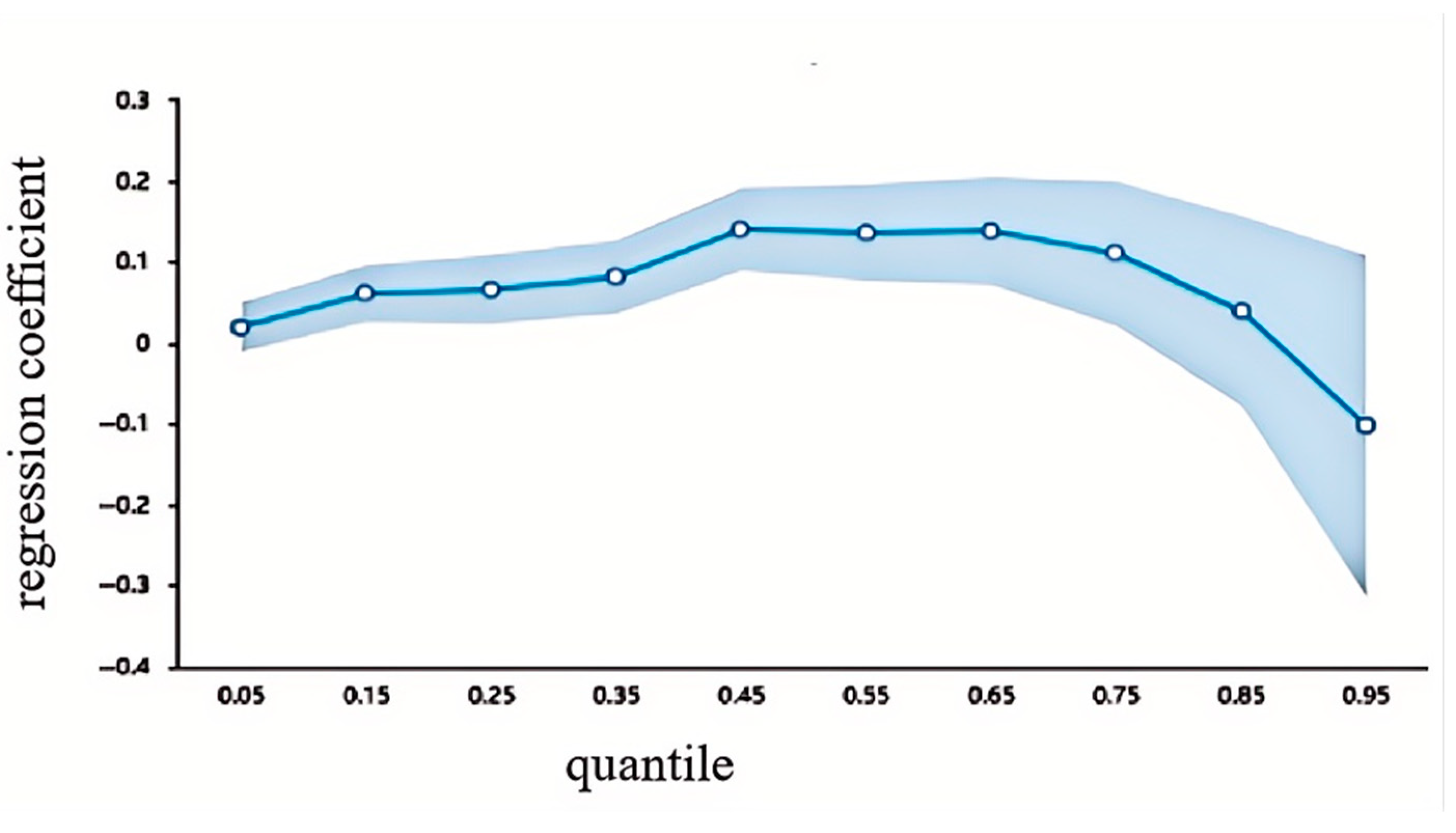Dynamic Decoding of VR Immersive Experience in User’s Technology-Privacy Game
Abstract
1. Introduction
2. Theoretical Framework and Research Hypotheses
2.1. Dynamic Decoding of VRIE: The Central Role of Flow Theory, Perceptual-Interactive Fidelity, and the Non-Linear Mechanism of Attention
- Spatial-Motor Fidelity: This refers to the system’s ability to accurately track user body movements, especially head and hands, and map them into the virtual space with low latency. It also includes the stability of the virtual space and the fluidity and responsiveness of visual presentation. This dimension is crucial for synchronizing users’ physical actions with feedback in the virtual world, directly impacting their proprioception and sense of control. It is specifically manifested by motion tracking accuracy and refresh rate and latency, the latter emphasizing the immediate visual response to actions and the smoothness of visuals during movement.
- Sensory Presentation Fidelity: This pertains to the authenticity, clarity, and richness of information presented through sensory channels such as vision (static image quality, color, detail, etc.), audition, and touch. It focuses more on the quality of the sensory stimuli themselves rather than dynamic visual fluidity related to motion. It is specifically manifested by haptic feedback capabilities. Although not directly isolated in this study’s data, display resolution, color accuracy, and sound quality also belong to this category.
- Interaction Comfort and Usability: This refers to the physiological comfort experienced by users during prolonged wear and use of VR devices, as well as the convenience and intuitiveness of interaction operations. It is specifically manifested by wearability comfort.
- Content Ecosystem Fidelity: This indicates whether the content provided by the VR platform—in terms of quantity, quality, diversity, and alignment with the system’s hardware capabilities—can meet user expectations to deliver sustained and meaningful virtual experiences. It is specifically manifested by content compatibility and richness.
2.2. The Technology-Privacy Game in VR: The Moderating Role of Privacy Calculus Theory and CWTI
2.3. Challenges to Behavioral Heuristics in VR Contexts: Re-Examination of Loss Aversion Theory
3. Research Methods
3.1. Data Source and Feature Extraction: Capturing Dynamic Attention Trajectories and Manifestations of Perceptual-Interactive Fidelity
- Dependent Variable: Changes in attention to semantic clusters related to Virtual Reality Immersive Experience.
- Independent Variables: Changes in attention to semantic clusters related to unique attributes of VR devices. These attributes are operationally mapped to the respective sub-dimensions of “Perceptual-Interactive Fidelity”.
- Moderating Variable: CWTI is indirectly measured and operationalized through the overall sentiment tendency, i.e., positive or negative, expressed in user reviews or words related to the acceptance of new technology features. To clarify this procedure, we employed a lexicon-based sentiment analysis method to process the reviews. The rationale for using sentiment as a proxy for CWTI is that users who express strong positive emotions towards a technology are generally considered to have a higher willingness to accept and immerse themselves in it, as emotions significantly influence technology acceptance behaviors [29]. Operationally, we calculated the sentiment polarity score for each review. This score was then binarized: reviews with a positive score (>0) were coded as representing high CWTI (value = 1), while those with a negative or neutral score (≤0) were coded as representing low CWTI (value = −1).
3.2. Model Setting and Analysis Strategy: Revealing Non-Linearity and Moderating Effects
- LAE part of H1 and H2: Through Models 1 and 2, we analyze the impact of changes in attention to device attributes (manifesting different sub-dimension indicators of PIF)—both average and individual—on changes in VRIE, as well as the moderating effect of CWTI in this relationship.
- Non-linear part of H1: We focus on analyzing the regression coefficients of Model 2 at different quantiles to see whether they present a systematic non-linear pattern. This reflects the optimal interval of attention to various aspects of PIF.
- H3 (Loss Aversion): Through Models 3 and 4, we compare the coefficients of the effects of positive and negative changes in attention to attributes (manifesting different sub-dimension indicators of PIF) on VRIE to test whether there is significant asymmetry.
4. Research Results
4.1. Confirmation of LAE, Non-Linear Characteristics of Attention, and VRIE
4.2. CWTI in the Technology-Privacy Game
4.3. Challenges in the Applicability of Loss Aversion Theory in VR Contexts
5. Discussion
5.1. Dynamic Decoding of VRIE Through Flow and Privacy Calculus Theories: Core Insights from an Integrated Perspective
5.2. Theoretical Innovation: Comparison with Existing Research
6. Conclusion and Implications
- The dynamic formation of VRIE depends on the achievement and maintenance of flow, with PIF being its crucial foundation: User attention to the unique attributes of VR devices, which collectively reflect the various sub-dimensions of their PIF, affects VRIE through the LAE, but this process is not a simple linear superposition. The non-linear effects of attention are prevalent. This indicates the existence of an “optimal attention threshold” or “optimal stimulation interval” for promoting flow; excessive or insufficient attention can impair the immersive experience.
- The technology-privacy game is a key contextual factor in VRIE formation, with CWTI playing a core moderating role: Users engage in privacy calculus when weighing the immersive benefits brought by VR technology and its PIF against concerns about privacy risks. CWTI significantly moderates their decisions by influencing their privacy calculus processes. Users with high CWTI are more inclined to accept potential risks for the sake of experience, making it easier for their positive attention to technological attributes to translate into VRIE improvement.
- Traditional behavioral heuristics face applicability challenges in VR: The study did not consistently support the predictive power of Loss Aversion Theory in VR contexts. This suggests that the unique interactive and experiential characteristics of VR may alter users’ traditional response patterns to positive and negative information.
Limitations and Future Research
Author Contributions
Funding
Data Availability Statement
Conflicts of Interest
Abbreviations
| VRIE | Virtual Reality Immersion Experience |
| CWTI | Consumers’ Willingness for Technological Immersion |
| LAE | Longitudinal Associative Effects |
| PIF | Perceptual-Interactive Fidelity |
References
- Slater, M.; Sanchez-Vives, M.V. Enhancing our lives with immersive virtual reality. Front. Robot. AI 2016, 3, 74. [Google Scholar] [CrossRef]
- Lee, H.; Chung, N.; Lee, S. Presence in virtual golf simulators: The effects of presence on perceived enjoyment, perceived value, and behavioral intention. New Media Soc. 2013, 15, 930–946. [Google Scholar] [CrossRef]
- Slater, M.; Wilbur, S. A framework for immersive virtual environments (FIVE): Speculations on the role of presence in virtual environments. Presence Teleoperators Virtual Environ. 1997, 6, 603–616. [Google Scholar] [CrossRef]
- Steuer, J. Defining virtual reality: Dimensions determining telepresence. J. Commun. 1992, 42, 73–93. [Google Scholar] [CrossRef]
- Javornik, A. Augmented reality: Research agenda for studying the impact of its media characteristics on consumer behavior. J. Retail. Consum. Serv. 2016, 30, 252–261. [Google Scholar] [CrossRef]
- Li, S.; Zhang, J.; Qin, Z. The Impact of Cue-Interaction Stimulation on Impulse Buying Intention on Virtual Reality Tourism E-commerce Platforms. J. Bus. Res. 2023, 155, 113456. [Google Scholar] [CrossRef]
- Li, L.; Yu, F.; Shi, D.; Shi, J.; Tian, Z.; Yang, J.; Wang, X.; Jiang, Q. Application of virtual reality technology in clinical medicine. Am. J. Transl. Res. 2017, 9, 3867. [Google Scholar]
- Loureiro, S.M.C.; Guerreiro, J.; Ali, F. 20 years of research on virtual reality and augmented reality in tourism context: A text-mining approach. Tour. Manag. 2020, 77, 104028. [Google Scholar] [CrossRef]
- Suh, A.; Prophet, J. The state of immersive technology research: A literature analysis. Comput. Hum. Behav. 2018, 86, 77–90. [Google Scholar] [CrossRef]
- Slater, M.; Spanlang, B.; Corominas, J. Simulating virtual environments within virtual environments as the basis for a psychophysics of presence. ACM Trans. Graph. TOG 2010, 29, 1–9. [Google Scholar] [CrossRef]
- Madary, M.; Metzinger, T.K. Real virtuality: A code of ethical conduct. Recommendations for good scientific practice and the consumers of VR-technology. Front. Robot. AI 2016, 3, 3. [Google Scholar]
- Duchowski, A.T. A breadth-first survey of eye-tracking applications. Behav. Res. Methods Instrum. Comput. 2002, 34, 455–470. [Google Scholar] [CrossRef] [PubMed]
- Tversky, A.; Kahneman, D. Availability: A heuristic for judging frequency and probability. Cogn. Psychol. 1973, 5, 207–232. [Google Scholar] [CrossRef]
- Shin, D. Empathy and embodied experience in virtual environment: To what extent can virtual reality stimulate empathy and embodied experience? Comput. Hum. Behav. 2018, 78, 64–73. [Google Scholar] [CrossRef]
- Csikszentmihalyi, M. Flow: The Psychology of Optimal Experience; Harper & Row: New York, NY, USA, 1990. [Google Scholar]
- Dinev, T.; Hart, P. An extended privacy calculus model for e-commerce transactions. Inf. Syst. Res. 2006, 17, 61–80. [Google Scholar] [CrossRef]
- Zhang, J.; Zheng, W.; Wang, S. The study of the effect of online review on purchase behavior Comparing the two research methods. Int. J. Crowd Sci. 2020, 4, 73–86. [Google Scholar] [CrossRef]
- Kousha, K.; Thelwall, M. Can Amazon. com reviews help to assess the wider impacts of books? J. Assoc. Inf. Sci. Technol. 2016, 67, 566–581. [Google Scholar] [CrossRef]
- Landauer, T.K.; Dumais, S.T. A solution to Plato’s problem: The latent semantic analysis theory of acquisition, induction, and representation of knowledge. Psychol. Rev. 1997, 104, 211. [Google Scholar] [CrossRef]
- Paivio, A. Dual coding theory: Retrospect and current status. Can. J. Psychol./Rev. Can. De Psychol. 1991, 45, 255. [Google Scholar] [CrossRef]
- Makransky, G.; Lilleholt, L. A structural equation modeling investigation of the emotional value of immersive virtual reality in education. Educ. Technol. Res. Dev. 2018, 66, 1141–1164. [Google Scholar] [CrossRef]
- Keith, M.J.; Thompson, S.C.; Hale, J.; Lowry, P.B.; Greer, C. Information disclosure on mobile devices: Re-examining privacy calculus with actual user behavior. Int. J. Hum. Comput. Stud. 2013, 71, 1163–1173. [Google Scholar] [CrossRef]
- Kahneman, D.; Tversky, A. Prospect theory: An analysis of decision under risk. In Handbook of the Fundamentals of Financial Decision Making: Part I; World Scientific: Singapore, 2013; pp. 99–127. [Google Scholar]
- Hirschman, E.C.; Holbrook, M.B. Hedonic consumption: Emerging concepts, methods and propositions. J. Mark. 1982, 46, 92–101. [Google Scholar] [CrossRef]
- Voss, K.E.; Spangenberg, E.R.; Grohmann, B. Measuring the hedonic and utilitarian dimensions of consumer attitude. J. Mark. Res. 2003, 40, 310–320. [Google Scholar] [CrossRef]
- Ryan, R.M.; Rigby, C.S.; Przybylski, A. The motivational pull of video games: A self-determination theory approach. Motiv. Emot. 2006, 30, 344–360. [Google Scholar] [CrossRef]
- Zhang, J.; Liu, M.; Li, Z. Impact of peer-to-peer online experience on cultural tourism marketing. Tour. Manag. 2022, 90, 104488. [Google Scholar]
- Kulkarni, S.S.; Apte, U.M.; Evangelopoulos, N.E. The use of latent semantic analysis in operations management research. Decis. Sci. 2014, 45, 971–994. [Google Scholar] [CrossRef]
- Beaudry, A.; Pinsonneault, A. The other side of acceptance: Studying the direct and indirect effects of emotions on information technology use. MIS Q. 2010, 34, 689–710. [Google Scholar] [CrossRef]
- Ahmad, S.N.; Laroche, M. Analyzing electronic word of mouth: A social commerce construct. Int. J. Inf. Manag. 2017, 37, 202–213. [Google Scholar] [CrossRef]
- Kwok, L.; Xie, K.L. Factors contributing to the helpfulness of online hotel reviews: Does manager response play a role? Int. J. Contemp. Hosp. Manag. 2016, 28, 2156–2177. [Google Scholar] [CrossRef]
- Gan, X.; Fernandez, I.C.; Guo, J.; Wilson, M.; Zhao, Y.; Zhou, B.; Wu, J. When to use what: Methods for weighting and aggregating sustainability indicators. Ecol. Indic. 2017, 81, 491–502. [Google Scholar] [CrossRef]
- Hair, J.F., Jr.; Black, W.C.; Babin, B.J.; Anderson, R.E.; Tatham, R.L. Multivariate Data Analysis; Prentice Hall: Upper Saddle River, NJ, USA, 1998; Volume 5. [Google Scholar]
- Neter, J.; Kutner, M.H.; Nachtsheim, C.J.; Wasserman, W. Applied Linear Statistical Models; Irwin: Chicago, IL, USA, 1996; Volume 4. [Google Scholar]
- Durbin, J.; Watson, G.S. Testing for serial correlation in least squares regression. II. In Breakthroughs in Statistics; Springer: New York, NY, USA, 1992; pp. 260–266. [Google Scholar]
- Lambrecht, A.; Tucker, C. Algorithmic bias? An empirical study of apparent gender-based discrimination in the display of STEM career ads. Manag. Sci. 2019, 65, 2966–2981. [Google Scholar] [CrossRef]
- Atasoy, O.; Morewedge, C.K. Digital goods are valued less than physical goods. J. Consum. Res. 2018, 44, 1343–1357. [Google Scholar] [CrossRef]
- O’Brien, H.L.; Toms, E.G. What is user engagement? A conceptual framework for defining and measuring engagement with technology. J. Am. Soc. Inf. Sci. Technol. 2008, 59, 938–955. [Google Scholar] [CrossRef]
- Davis, F.D. Perceived usefulness, perceived ease of use, and user acceptance of information technology. MIS Q. 1989, 13, 319–340. [Google Scholar] [CrossRef]




| Concept | Label | Singular Value | High-Load Item |
|---|---|---|---|
| Concept 1 | Motion Tracking Accuracy | 933.43 | Tracking, precision, accuracy, sensor, movement… |
| Concept 2 | Wearability Comfort | 282.40 | Comfort, fit, experience, adjust, feel… |
| Concept 3 | Content Compatibility and Richness | 255.69 | App, support, service, email, contact… |
| Concept 4 | VRIE | 238.58 | Immersion, presence, realism, engagement, environment… |
| Concept 5 | Refresh Rate and Latency | 221.61 | Refresh rate, response time, latency, smoothness… |
| Concept 6 | Haptic Feedback Capabilities | 217.30 | Haptic, feedback, tactile, vibration, force feedback… |
| Model | Function |
|---|---|
| Model 1 | |
| Model 2 | |
| Model 3 | |
| Model 4 |
| Model 1 Regression Results Under Consumer Positive Sentiment | ||||||
| Indicator | OLS Coefficient | 15th Percentile | 35th Percentile | 55th Percentile | 75th Percentile | 95th Percentile |
| Constant | - | −0.605 * (−60.447) | −0.375 ** (−28.773) | −0.101 ** (−5.983) | 0.283 ** (11.818) | 1.279 ** (20.358) |
| Changes in Average Attributes | 0.598 ** (24.929) | 0.176 ** (17.339) | 0.379 ** (29.002) | 0.606 ** (36.136) | 0.884 ** (42.377) | 1.667 ** (36.911) |
| 0.358 | ||||||
| Model 1 Regression Results under Consumer Negative Sentiment | ||||||
| Indicator | OLS Coefficient | 15th Percentile | 35th Percentile | 55th Percentile | 75th Percentile | 95th Percentile |
| Constant | - | −0.710 ** (−42.932) | −0.424 ** (−21.921) | −0.109 ** (−4.264) | 0.323 ** (9.239) | 1.578 ** (20.640) |
| Changes in Average Attributes | 0.501 ** (17.075) | 0.181 ** (12.161) | 0.348 ** (17.376) | 0.512 ** (20.490) | 0.740 ** (23.992) | 1.600 ** (29.260) |
| 0.251 | ||||||
| Model 2 Regression Results Under Consumer Positive Sentiment | ||||||
| Indicator | OLS Coefficient | 15th Percentile | 35th Percentile | 55th Percentile | 75th Percentile | 95th Percentile |
| Constant | - | −0.597 ** (−58.972) | −0.358 ** (−28.837) | −0.083 ** (−4.978) | 0.307 ** (14.758) | 1.259 ** (21.341) |
| Change in Concept 1 | 0.335 ** (9.022) | 0.141 ** (8.461) | 0.203 ** (9.852) | 0.294 ** (10.775) | 0.460 ** (13.266) | 0.255 (1.679) |
| Change in Concept 2 | 0.337 ** (11.588) | 0.061 ** (4.472) | 0.179 ** (11.379) | 0.303 ** (14.293) | 0.376 ** (14.828) | 0.842 ** (12.391) |
| Change in Concept 3 | −0.06 ** (−2.145) | −0.016 (−1.151) | −0.016 (−0.956) | −0.039 * (−1.972) | −0.027 (−1.146) | 0.352 ** (6.002) |
| Change in Concept 5 | 0.172 ** (6.054) | 0.013 (1.137) | 0.115 ** (7.520) | 0.177 ** (8.367) | 0.374 ** (13.391) | 0.433 ** (5.142) |
| Change in Concept 6 | −0.031 (−0.96) | 0.045 ** (2.825) | 0.013 (0.738) | 0.041 (1.720) | −0.031 (−1.036) | 0.017 (0.240) |
| 0.431 | ||||||
| Model 2 Regression Results under Consumer Negative Sentiment | ||||||
| Indicator | OLS Coefficient | 15th Percentile | 35th Percentile | 55th Percentile | 75th Percentile | 95th Percentile |
| Constant | - | −0.694 ** (−42.349) | −0.406 ** (−21.566) | −0.074 ** (−3.052) | 0.367 ** (10.816) | 1.511 ** (23.374) |
| Change in Concept 1 | 0.275 ** (7.424) | 0.160 ** (8.039) | 0.202 ** (7.721) | 0.249 ** (8.102) | 0.465 ** (10.804) | 1.025 ** (9.156) |
| Change in Concept 2 | 0.145 ** (3.9) | 0.004 (0.214) | 0.115 ** (4.871) | 0.193 ** (6.123) | 0.344 ** (7.448) | 0.568 ** (6.206) |
| Change in Concept 3 | 0.132 ** (3.717) | 0.062 ** (3.507) | 0.084 ** (3.683) | 0.137 ** (4.580) | 0.111 * (2.448) | −0.102 (−0.953) |
| Change in Concept 5 | 0.178 ** (5.456) | 0.037 (1.895) | 0.066 ** (3.174) | 0.197 ** (7.078) | 0.233 ** (5.773) | 0.539 ** (5.689) |
| Change in Concept 6 | −0.026 (−0.755) | −0.004 (−0.239) | 0.002 (0.074) | −0.033 (−1.147) | −0.035 (−0.877) | 0.127 (1.478) |
| 0.291 | ||||||
| Model 3 Regression Results Under Consumer Positive Sentiment | ||||||
| Indicator | OLS Coefficient | 15th Percentile | 35th Percentile | 55th Percentile | 75th Percentile | 95th Percentile |
| Constant | - | −0.637 ** (−62.566) | −0.444 ** (−32.412) | −0.179 ** (−8.802) | 0.269 ** (7.817) | 1.545 ** (17.380) |
| Positive Change in Average Attributes | 0.361 ** (−12.73) | 0.105 ** (11.030) | 0.194 ** (13.427) | 0.314 ** (15.235) | 0.486 ** (14.118) | 1.035 ** (15.013) |
| Negative Change in Average Attributes | −0.346 ** (13.289) | −0.073 ** (−6.512) | −0.176 ** (−13.107) | −0.280 ** (−13.652) | −0.536 ** (−15.572) | −1.009 ** (−13.881) |
| 0.205 | ||||||
| Model 3 Regression Results under Consumer Negative Sentiment | ||||||
| Indicator | OLS Coefficient | 15th Percentile | 35th Percentile | 55th Percentile | 75th Percentile | 95th Percentile |
| Constant | - | −0.738 ** (−45.916) | −0.462 ** (−22.150) | −0.158 ** (−5.872) | 0.350 ** (7.595) | 1.569 ** (14.877) |
| Positive Change in Average Attributes | 0.34 ** (10.367) | 0.079 ** (5.014) | 0.205 ** (9.674) | 0.287 ** (10.344) | 0.566 ** (11.785) | 0.876 ** (8.175) |
| Negative Change in Average Attributes | −0.323 ** (−9.826) | −0.127 ** (−8.437) | −0.231 ** (−11.024) | −0.326 ** (−11.527) | −0.477 ** (−10.994) | −0.795 ** (−7.960) |
| 0.153 | ||||||
| Model 4 Regression Results under Consumer Positive Sentiment | ||||||
| Indicator | OLS Coefficient | 15th Percentile | 35th Percentile | 55th Percentile | 75th Percentile | 95th Percentile |
| Constant | - | −0.633 ** (−161.593) | −0.429 ** (−76.035) | −0.150 ** (−16.736) | 0.250 ** (19.638) | 1.529 ** (36.148) |
| Positive Change in Concept 1 | 0.225 ** (18.996) | 0.080 ** (21.593) | 0.162 ** (29.256) | 0.246 ** (27.349) | 0.348 ** (28.884) | 0.508 ** (13.384) |
| Negative Change in Concept 1 | −0.184 ** (−15.488) | −0.062 ** (−19.658) | −0.116 ** (−21.170) | −0.179 ** (−20.073) | −0.270 ** (−22.365) | −0.437 ** (−11.956) |
| Positive Change in Concept 2 | 0.21 ** (17.71) | 0.065 ** (19.342) | 0.112 ** (20.135) | 0.199 ** (21.856) | 0.296 ** (22.432) | 0.535 ** (13.376) |
| Negative Change in Concept 2 | −0.191 ** (−16.111) | −0.042 ** (−9.566) | −0.115 ** (−20.268) | −0.178 ** (−19.764) | −0.269 ** (−20.406) | −0.555 ** (−13.158) |
| Positive Change in Concept 3 | 0.146 ** (12.294) | 0.035 ** (6.488) | 0.085 ** (13.676) | 0.135 ** (15.401) | 0.280 ** (23.193) | 0.578 ** (18.948) |
| Negative Change in Concept 3 | −0.143 ** (−12.066) | −0.033 ** (−6.094) | −0.080 ** (−13.154) | −0.182 ** (−20.399) | −0.262 ** (−23.284) | −0.491 ** (−15.052) |
| Positive Change in Concept 5 | 0.17 ** (14.301) | 0.059 ** (16.599) | 0.098 ** (16.575) | 0.165 ** (18.645) | 0.270 ** (21.422) | 0.480 ** (11.314) |
| Negative Change in Concept 5 | −0.185 ** (−15.586) | −0.052 ** (−14.660) | −0.125 ** (−23.254) | −0.163 ** (−18.316) | −0.294 ** (−22.302) | −0.497 ** (−10.314) |
| Positive Change in Concept 6 | 0.163 ** (13.785) | 0.048 ** (12.366) | 0.088 ** (15.146) | 0.161 ** (18.499) | 0.261 ** (22.405) | 0.543 ** (17.779) |
| Negative Change in Concept 6 | −0.164 ** (−13.884) | −0.049 ** (−14.370) | −0.126 ** (−23.409) | −0.165 ** (−18.437) | −0.259 ** (−22.243) | −0.412 ** (−12.476) |
| 0.228 | ||||||
| Model 4 Regression Results under Consumer Negative Sentiment | ||||||
| Indicator | OLS Coefficient | 15th Percentile | 35th Percentile | 55th Percentile | 75th Percentile | 95th Percentile |
| Constant | - | −0.749 ** (−119.295) | −0.494 ** (−56.568) | −0.194 ** (−15.103) | 0.300 ** (13.319) | 1.753 ** (28.384) |
| Positive Change in Concept 1 | 0.153 ** (10.417) | 0.067 ** (10.135) | 0.121 ** (12.960) | 0.165 ** (12.744) | 0.235 ** (10.399) | 0.359 ** (6.892) |
| Negative Change in Concept 1 | −0.156 ** (−10.57) | −0.077 ** (−12.566) | −0.103 ** (−10.828) | −0.157 ** (−12.260) | −0.229 ** (−10.381) | −0.389 ** (−4.966) |
| Positive Change in Concept 2 | 0.144 ** (9.753) | 0.034 ** (5.045) | 0.108 ** (12.424) | 0.156 ** (11.888) | 0.194 ** (8.565) | 0.361 ** (6.100) |
| Negative Change in Concept 2 | −0.125 ** (−8.482) | −0.058 ** (−7.814) | −0.102 ** (−10.898) | −0.137 ** (−10.608) | −0.172 ** (−7.879) | −0.390 ** (−6.556) |
| Positive Change in Concept 3 | 0.119 ** (8.079) | 0.056 ** (10.347) | 0.096 ** (10.730) | 0.135 ** (10.264) | 0.150 ** (6.124) | 0.283 ** (3.017) |
| Negative Change in Concept 3 | −0.075 ** (−5.069) | −0.026 ** (−4.442) | −0.037 ** (−4.199) | −0.062 ** (−4.733) | −0.104 ** (−4.346) | −0.347 ** (−6.912) |
| Positive Change in Concept 5 | 0.051 ** (3.459) | 0.025 ** (3.503) | 0.045 ** (4.994) | 0.059 ** (4.544) | 0.073 ** (3.327) | 0.125 * (2.032) |
| Negative Change in Concept 5 | −0.056 ** (−3.819) | −0.015 * (−2.438) | −0.025 ** (−2.765) | −0.039 ** (−3.037) | −0.069 ** (−3.223) | −0.329 ** (−5.989) |
| Positive Change in Concept 6 | 0.043 ** (2.922) | 0.008 (1.163) | 0.013 (1.407) | 0.024 (1.877) | 0.059 ** (2.734) | 0.174 ** (3.824) |
| Negative Change in Concept 6 | −0.07 ** (−4.757) | −0.020 ** (−2.802) | −0.058 ** (−6.423) | −0.070 ** (−5.451) | −0.129 ** (−5.735) | −0.267 ** (−5.478) |
| 0.283 | ||||||
Disclaimer/Publisher’s Note: The statements, opinions and data contained in all publications are solely those of the individual author(s) and contributor(s) and not of MDPI and/or the editor(s). MDPI and/or the editor(s) disclaim responsibility for any injury to people or property resulting from any ideas, methods, instructions or products referred to in the content. |
© 2025 by the authors. Licensee MDPI, Basel, Switzerland. This article is an open access article distributed under the terms and conditions of the Creative Commons Attribution (CC BY) license (https://creativecommons.org/licenses/by/4.0/).
Share and Cite
Li, S.; Qin, Z.; Liu, M.; Li, Z.; Zhang, J.; Wei, Y. Dynamic Decoding of VR Immersive Experience in User’s Technology-Privacy Game. Systems 2025, 13, 638. https://doi.org/10.3390/systems13080638
Li S, Qin Z, Liu M, Li Z, Zhang J, Wei Y. Dynamic Decoding of VR Immersive Experience in User’s Technology-Privacy Game. Systems. 2025; 13(8):638. https://doi.org/10.3390/systems13080638
Chicago/Turabian StyleLi, Shugang, Zulei Qin, Meitong Liu, Ziyi Li, Jiayi Zhang, and Yanfang Wei. 2025. "Dynamic Decoding of VR Immersive Experience in User’s Technology-Privacy Game" Systems 13, no. 8: 638. https://doi.org/10.3390/systems13080638
APA StyleLi, S., Qin, Z., Liu, M., Li, Z., Zhang, J., & Wei, Y. (2025). Dynamic Decoding of VR Immersive Experience in User’s Technology-Privacy Game. Systems, 13(8), 638. https://doi.org/10.3390/systems13080638






